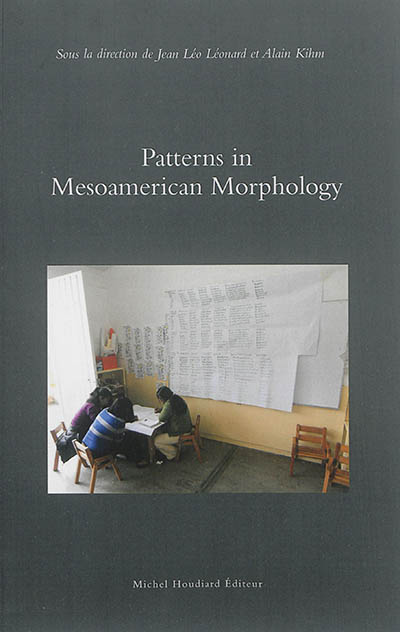en savoir plus

Permet à tous ses détenteurs d'obtenir 5% de réduction sur tous les livres lors du retrait en magasin (réduction non cumulable avec les réductions de type étudiant).
Offre également un certain nombre d'avantages auprès de nos partenaires.
Avec les favoris, retrouvez dans un espace les sélections effectuées au fur et à mesure de vos navigations dans le site.
Constituez pour votre usage personnel vos listes de livres en prévisions d'achats futurs et votre sélection d'articles, dossiers, événements, vidéos ou podcasts préférés ou à découvrir plus tard...
Il suffit simplement de cliquer sur "Ajout Favori" sur chaque page qui vous intéresse pour les retrouver ensuite dans votre espace personnel.
Requiert un compte Mollat
Requiert un compte Mollat
Patterns in Mesoamerican morphology
en savoir plus
Résumé
Ces études rendent compte de la complexité morphosyntaxique des langues mésoaméricaines tout en éclairant leurs caractéristiques grammaticales communes, probablement liées à des environnements culturels similaires. L'ensemble témoigne de divers aspects sociolinguistiques tout en mettant l'accent sur la morphologie flexionnelle. Il livre un important matériau pour la recherche dans ce domaine. ©Electre 2025
Quatrième de couverture
Mesoamerican languages have long attracted the attention of linguists. Their often bewildering morphosyntactic complexity, in terms of number of possible forms and constructions as well as of systemic opacity, presents an exciting challenge for all theories aiming to devise models of how humans know, acquire and process their languages.
Although they belong to several, apparently unrelated stocks - Mayan, Mixe-Zoque, Otomanguean, Totonac, Uto-Aztecan, and isolates (Huave or Ombeayiüts, Purepecha) - most or all Amerindian languages spoken between the Northern border of Mexico and Costa-Rica share a number of grammatical features, probably as a result of having coexisted in similar natural and cultural environments for thousands of years. Mesoamerican languages thus offer rich material for research in historical and areal linguistics.
Many of these languages are still thriving despite the enduring and pervasive presence of the originally colonial language, Spanish. Recent years have even seen a renewal of the efforts to promote at least some of them to the status of written languages and to use them as teaching media in local schools. Rich opportunities are thus offered not only to specialists in language development, but to all field linguists who consider social benefits to the people they study a crucial aspect of their work.
In this volume, the focus on inflectional morphology is easily justified by the already mentioned attribute many of these languages share, namely dauntingly complex paradigms, especially in the verbal domain. Not only are the various, semantically distinct forms assumed by one lexeme extremely numerous, but the phonological relations between the forms are often complex, sometimes quite opaque. Such a state of affairs makes Mesoamerican languages a central piece in current debates in morphological theory.
We hope this book will provide seminal insight into the complexity of morphological patterns in Mesoamerican languages from a plurality of prospects (language by itself, formal grammars, pragmatic and semiotic embedding of categories, interfaces between phonology, morphology and syntax, language in society, complexity theory), and will substantially contribute to foster interdisciplinary research in the field.
Fiche Technique
Paru le : 20/10/2014
Thématique : Adultes méthodes grand public
Auteur(s) : Non précisé.
Éditeur(s) :
M. Houdiard
Collection(s) : Non précisé.
Contributeur(s) : Editeur scientifique (ou intellectuel) : Jean-Léo Léonard - Editeur scientifique (ou intellectuel) : Alain Kihm
Série(s) : Non précisé.
ISBN : 978-2-35692-120-8
EAN13 : 9782356921208
Reliure : Broché
Pages : 303
Hauteur: 24.0 cm / Largeur 16.0 cm
Épaisseur: 1.7 cm
Poids: 400 g

